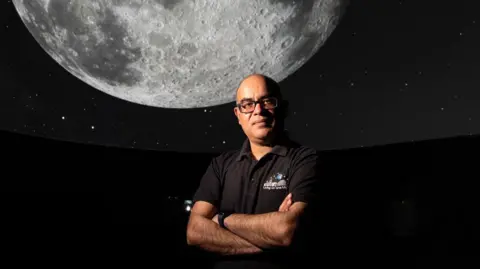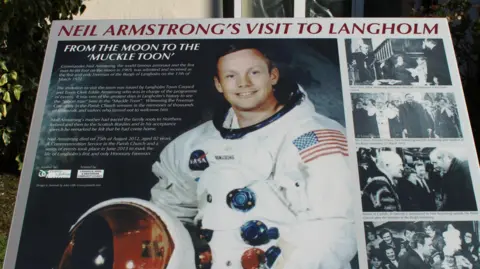Neil Armstrong link draws lunar experts to Scotland
 Getty Images
Getty ImagesThe south of Scotland's link to the first man on the Moon has helped bring dozens of lunar experts to Dumfries and Galloway.
Neil Armstrong traced his roots back to Langholm and visited the town in 1972 when he was made a freeman.
Now the European Lunar Symposium (ELS) is taking place in Dumfries - the first time it has been staged in Scotland.
Prof Mahesh Anand, who chairs the group, said he had been unaware of the area's lunar connections but when he found out he was keen to see it host the event.
 Mike Bolam
Mike BolamArmstrong - who was born and raised in the United States - became one of the most famous men on the planet after the Moon landing in 1969.
He was proud of his Scottish roots and eventually visited Langholm a few years later to see the historic heartland of his clan.
"The most difficult place to be recognised is in one's own home town and I consider this, now, my home town," he said at the time.
Prof Anand - from the Open University - described it as a "happy accident" that the ELS had come to Scotland.
 Billy McCrorie
Billy McCrorie"I happened to be in Dumfries delivering a lecture back in February 2020 - just before the pandemic struck," he explained.
"During that trip I found out that there was a historical link with lunar exploration in Dumfries and Galloway - the link being Langholm being the ancestral home town of Neil Armstrong.
"Neil Armstrong actually visited Langholm in 1972 which I only found out when I was there for my lecture trip."
He said that gave him the idea to look at bringing the symposium to the area.
"That just inspired me to actually think about bringing the current lunar activities and whatever is happening around the world with lunar exploration back to perhaps where it all might have begun," he explained.
A range of events is taking place including school visits, talks and a pop-up museum at the Crichton Memorial Church.
Prof Anand said he was delighted to bring delegates to such a "beautiful part of the country".
He said attendees had come from as far afield as Hawaii and China to be part of proceedings.
And, despite its relative proximity, he said there was still much that was unknown about the Moon.
"We think that we know everything about the Moon because the Moon is the most visible object in the night sky and it has been observed by humans for thousands of years," he said.
"And, of course, humans have even walked on the lunar surface and have brought samples back to earth.
"There is still a lot to be learned about the Moon."
